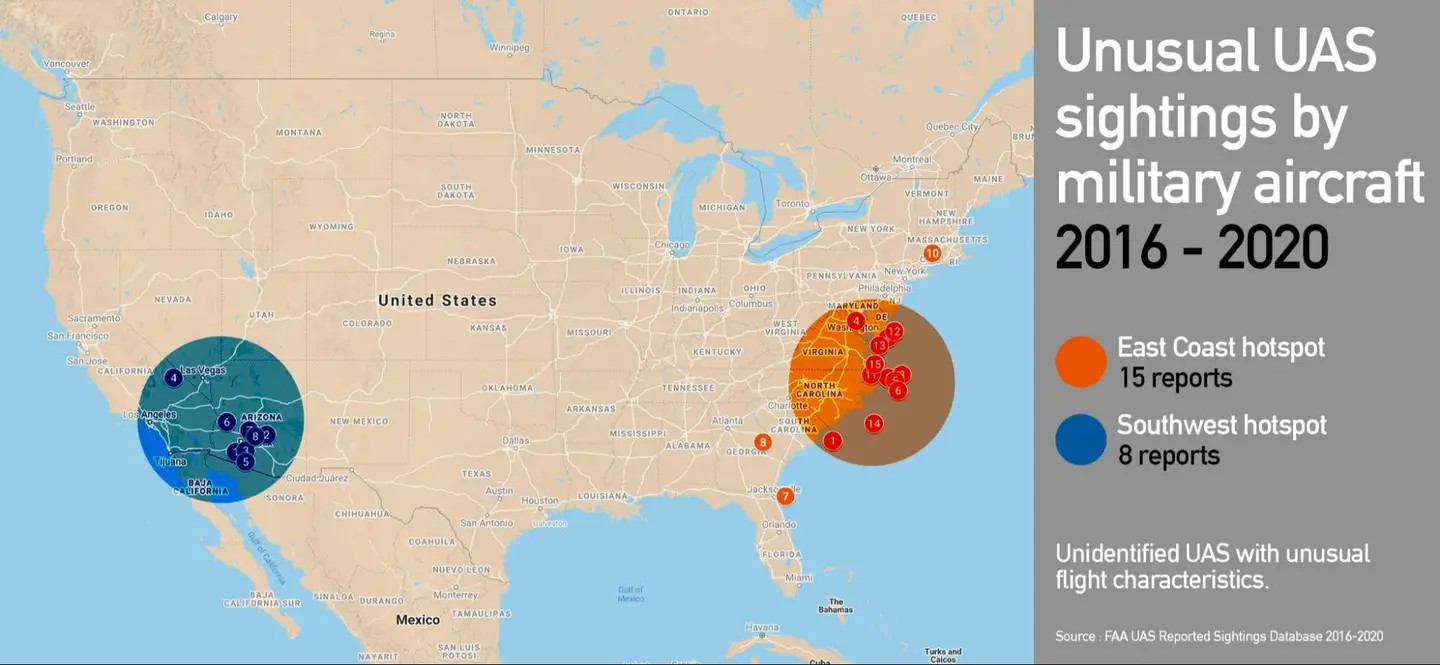The Pentagon has provided new details about a deployable, readily reconfigurable suite of sensors called Gremlin being developed specifically to help gather data about so-called unidentified anomalous phenomena, or UAPs. UAP is the preferred term for what have been more commonly called unidentified flying objects, or UFOs, in the past. That the U.S. military was pursuing “purpose-built sensors” for this purpose was first disclosed last year.
Tim Phillips, the acting director of the All-domain Anomaly Resolution Office (AARO), discussed the Gremlin “kits” with reporters ahead of the release earlier today of an unclassified version of the first volume of a Congressionally-mandated review of U.S. government involvement in matters related to UAPs. That report notably poured cold water on claims that American authorities have been hiding a program that has recovered extraterrestrial technology and actual alien remains. Not surprisingly, some have welcomed the report, while others have claimed it is just more evidence of a cover-up.
AARO was created in 2022 to act as a focal point for refining and centralizing Pentagon-wide policies and procedures for tracking, reporting, and analyzing UAP incidents. It has also been tasked with acting as a U.S. military repository for UAP-related intelligence assessments and other data. The video below is an example of a reported UAP sighting that AARO has reviewed and information that is now in its repository. This incident was subsequently assessed to have involved a trio of commercial aircraft.

“Although many UAP reports remain unsolved or unidentified, AARO assesses that if more and better quality data were available, most of these cases also could be identified and resolved as ordinary objects or phenomena,” according to the report. “Sensors and visual observations are imperfect; the vast majority of cases lack actionable data or the data available is limited or of poor quality.”
This is exactly why AARO is pursuing the Gremlin sensor systems.
“We’re working with some of the government labs, such as the Department of Energy labs, and we have a great partner with Georgia Tech. And what we’re doing is developing a deployable, configurable sensor suite that we can put in Pelican cases,” AARO’s acting head Phillips’ said, according to DefenseScoop. “We’re going to be able to pull it to the field to do a long-term [collection]. Since the UAP target – that signature is not clearly defined – we really have to do hyperspectral surveillance to try to capture these incidents.”
Exactly what kinds of sensors are available for the Gremlin kit now or that might be in development for inclusion in it in the future are unknown. “Hyperspectral” typically refers to sensors capable of capturing imagery across different areas of the electromagnetic spectrum simultaneously. This allows for the collection of data about a target’s signature composition across multiple spectrums simultenously, which can then be analyzed and/or combined and compared against, and otherwise compiled with other sensor data for a better overall understanding of what is being surveilled. As an example, the U.S. military has used aircraft equipped with hyperspectral imaging systems to find targets hidden beneath natural and man-made camouflage and even ones, such as improvised explosive devices, that might be buried just below the surface.
The NASA video below offers a good general explanation of what can be gleaned from hyperspectral analysis.
The network of national security laboratories under the purview of the Department of Energy that Phillips noted as helping with the Gremlin systems have a long history of work on hyperspectral sensors. This includes one family of designs known collectively as Big Green that have been utilized operationally by the U.S. military. Though most commonly associated with nuclear weapons development, these facilities are responsible for a wide array of advanced technology efforts, many of them very heavily classified, as you can read more about here.
Hyperspectral imaging, as well as related multispectral imaging, capabilities have become far more widespread in recent years and have bled over into the commercial sector, as well. These systems, are increasingly key sensor capabilities for use in a wide array of contexts.
“Understanding if any of these Earth sensing satellites, any of these airborne platforms, any of these ground radars – whether it’s FAA or other – can actually see these things, given what we’ve got so far is going to be an important first step to understanding what sensors are going to be relevant,” Sean Kirkpatrick, AARO’s first director and Phillips’ predecessor, said at a Congressional hearing in May 2023. Kirkpatrick, who left the post last December, also disclosed at that time that his office was pursuing “dedicated sensors that we’ve purpose-built designed to detect, track and characterize” potential UAPs.

All of this is fully in line with what Phillips said the Gremlin systems have already shown they can do in tests in Texas. That testing has included “known” targets, or ones that sensor operators are informed about beforehand, as well as “unknown” ones, DefenseScoop reported. Using known targets, which have reportedly been drones, would allow personnel to get a sense first of how the system works and what it can and cannot detect.
The sensors have also shown their ability to pick up a wide array of unintended targets, Phillips said, according to Task & Purpose. This has included “a lot of bats and birds,” but also things happening outside of the Earth’s atmosphere that may or may not be visible to the naked eye.
“We’re learning a lot about solar flaring,” Phillips said. “We’re really starting to understand what’s in orbit around our planet and how we can eliminate those as anomalous objects.”
The goal now is to refine Gremlin to the point where it can be actively deployed in response to reports of incidents. As The War Zone has reported in the past, potential UAP sightings have occurred in clusters, sometimes over periods of days or even longer. Certain areas also seem to produce more reports, as you can see in the map below in a map generated using an interactive online tool created for The War Zone that utilizes Federal Aviation Administration (FAA) data.

Military test and training ranges and other designated operating areas in the United States and just off its coastlines have been particular hotbeds of UAP reports, as The War Zone has reported on in the past on multiple occasions. Former AARO director Kirkpatrick noted last year that the clustering of UAP reports often appeared to be “biased” toward “where our [existing] sensors are.”
“If we have a national security site and there are objects being reported that [are] within restricted airspace or within a maritime range or within the proximity of one of our spaceships, we need to understand what that is,” Phillips said, according to CNN. “And so that’s why we’re developing sensor capability that we can deploy in reaction to reports.”
Just since its establishment in 2022, AARO has already assessed dozens of reported UAP incidents to have actually involved readily identifiable things like drones and balloons. Phillips calls these reports “AARO garbage,” though it is worth noting that drones and balloons present a variety of very real potential national security threats, something The War Zone regularly highlights.
The video below was taken during a reported UAP incident in 2022 that was subsequently assessed to have involved a group of drones.

For his part, AARO’s acting director does seem to be well aware of this reality.
“I want to support the warfighter. I want to go after the cases that we received this week. As for where I want to be, I want to have my officers out in the field, talking to witnesses trying to gather and preserve evidence, trying to work with the services and the other departments in the government on how to preserve data when there are incidents, helping to write force protection standards, so I can capture this in real-time,” Phillips said, per DefenseScoop. “Doing it forensically, after the fact, is difficult.”
Having deployable Gremlin sensor systems will only help AARO be more proactive in gathering data about potential UAPs and help assess what they are more conclusively.
Contact the author: joe@twz.com
